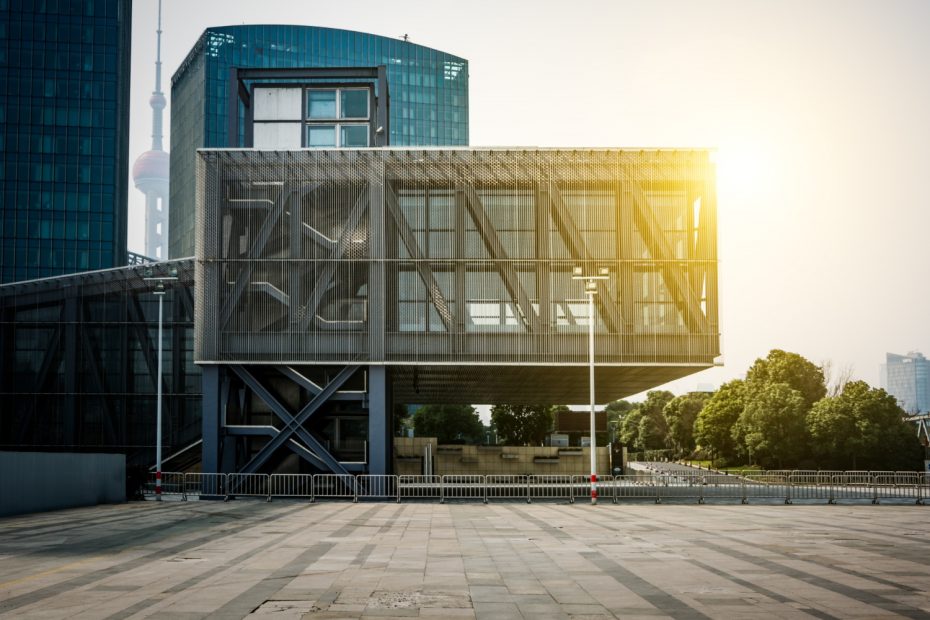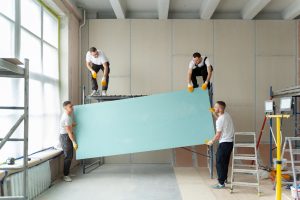Traditional and modular construction have become two main methods widely used in modern warehouse development today. Warehouses are essential facilities in the world of industry, logistics, and trade. Their role is not only as storage space but also as distribution centers that support the smooth operation of supply chains. As the demand for efficiency and speed in business operations increases, warehouse construction has become one of the top priorities for companies.
When building a warehouse, the choice between traditional and modular construction often becomes a key consideration. Both methods have their own advantages and disadvantages, making it important for companies to align them with long-term needs as well as budget conditions.
To make the right choice, companies must have a thorough understanding of the comparison between traditional and modular warehouse construction. Factors such as cost, project timeline, flexibility, and environmental impact must be considered to ensure that the investment is truly effective.
This article will discuss both methods in detail from various aspects, such as time, cost, quality, flexibility, environmental impact, and scalability. With a comprehensive understanding of the differences between traditional and modular construction, companies can make more strategic decisions to support operational efficiency and strengthen business competitiveness.
What Is Traditional Construction?
Traditional construction is a conventional building method carried out entirely on the project site. All stages, such as foundation excavation, installation of steel or concrete structures, walls, roofing, and finishing, are conducted directly on-site.
Characteristics of traditional construction:
- Step-by-step and sequential work process.
- Requires a large workforce with diverse skills.
- Construction time is influenced by external factors such as weather and material availability.
- Easier to make design changes during the construction process.
This method is still widely used in Indonesia because it is considered more familiar to contractors and on-site workers.
What Is Modular Construction?
Modular construction is a modern building method that uses a prefabrication system. Most warehouse components are manufactured in factories under specific quality standards and then transported to the project site for assembly.
Characteristics of modular construction:
- Production process carried out in factories (off-site).
- Building components such as walls, roofs, and structures are made with precision machinery.
- On-site construction is shorter since it mostly involves assembly.
- Produces less material waste and is environmentally friendly.
This method is becoming increasingly popular as it offers fast, efficient, and flexible solutions for building industrial facilities such as warehouses.
Comparison of Traditional and Modular Construction Methods for Warehouses
1. Construction Time
-
Traditional Construction: The process takes relatively longer since all stages are carried out manually on-site. For example, foundation construction requires specific time before moving on to the next stage. In addition, external factors such as heavy rainfall may disrupt the work. As a result, warehouse construction can take months, sometimes even longer than initially planned.
-
Modular Construction: The process is much faster since most components are pre-manufactured in factories. On-site workers only need to assemble the ready-made modules. This method can cut project time by 30–50% compared to traditional methods. For businesses that need warehouses ready for operations quickly, modular construction is an ideal solution.
2. Construction Costs
-
Traditional Construction: Project costs often overrun due to delays, material waste, and the need for a larger workforce. For example, if bad weather delays work, operational and labor costs must still be paid. Additionally, damaged or wasted materials on-site further add to the expenses.
-
Modular Construction: Costs are more controlled since component production is carried out in factories with precise material calculations. Although the initial investment may be slightly higher, long-term efficiency makes it more economical. Furthermore, because construction time is shorter, companies can operate their warehouses sooner, accelerating return on investment.
3. Building Quality
-
Traditional Construction: The quality of the building largely depends on the skills of workers and site conditions. There is a risk of varying quality in different parts of the structure since work is done manually. For instance, the quality of concrete casting may differ from one section to another, depending on who worked on it and the weather conditions at the time.
-
Modular Construction: Quality is more consistent because all components are produced in factories under strict standards and precision machinery. This minimizes the risk of human error and ensures more uniform building quality. Modular warehouses generally have high standards of durability and longevity.
4. Design Flexibility
-
Traditional Construction: Highly flexible and easily customized. If design changes are needed mid-project, this method allows for adjustments, though it may increase costs and extend the timeline. It is suitable for warehouses with special designs or unique requirements that cannot be met by standard modules.
-
Modular Construction: Design flexibility is more limited since modules are prefabricated in specific sizes. However, technological advancements now allow modules to be customized according to business needs. For example, warehouse modules can be designed to accommodate high storage racks or include built-in office spaces.
5. Environmental Impact
-
Traditional Construction: On-site work generates significant material waste, such as leftover cement, steel scraps, and formwork timber. In addition, the use of heavy machinery produces noise and dust pollution that disrupts the surrounding environment.
-
Modular Construction: More environmentally friendly since components are manufactured in factories with precise calculations, resulting in less waste. Shorter on-site work duration also reduces pollution and minimizes environmental disturbances.
6. Scalability and Relocation
-
Traditional Construction: Warehouses built with this method are permanent. Relocating the facility is nearly impossible without complete demolition. Expansion also requires substantial time and cost.
-
Modular Construction: Offers significant scalability advantages. Modular warehouses can be expanded by simply adding new modules as business needs grow. In fact, some modular systems allow for relocation to different sites, making them more flexible for companies with expansion plans.
Key Factors in Choosing Between Traditional and Modular Construction
When deciding between traditional and modular construction, companies cannot base their choice solely on costs or construction time. Several other factors must be thoroughly considered to ensure that warehouse or industrial facility investments are accurate and effective.
1. Long-Term Needs
The first factor is the long-term purpose of the building. If the warehouse is intended for permanent use at a fixed location, traditional construction is generally more suitable. This method provides stronger structural durability and greater design flexibility to create robust buildings tailored to a company’s specific needs.
However, if the company anticipates future expansion, relocation, or scaling of production, modular construction becomes the more beneficial option. Modular systems allow for easier expansion and relocation compared to traditional methods. This enables businesses to adapt more quickly to market changes.
2. Budget Availability
Another important aspect is the available budget. Many companies with limited funds tend to choose traditional construction since it is more familiar and can be carried out in stages according to cash flow. Although overall costs may be higher in the long run, traditional construction remains attractive because of its financial flexibility.
On the other hand, modular construction requires relatively higher upfront capital. Yet, over the long term, it provides significant cost efficiency. Factory production minimizes material waste, shortens construction time, and reduces operational costs once the warehouse is completed. For this reason, companies with long-term visions often view modular construction as a strategic investment.
3. Level of Urgency
Urgency is also a crucial factor in selecting between traditional and modular construction. If a warehouse is urgently needed, such as during a surge in logistics or production demand, modular construction is the best solution. Its process can cut project time by 30–50% compared to traditional methods, as most work is done in factories.
Meanwhile, traditional construction takes longer. Weather, labor availability, and potential material delays can further extend the project timeline. Therefore, for companies requiring rapid facility readiness, modular construction is the more strategic choice.
4. Type of Goods Stored
The type of goods to be stored in the warehouse also affects the choice of construction method. For example, warehouses intended for storing chemicals, pharmaceuticals, or other hazardous materials require highly specific designs and safety systems. In this case, traditional construction is superior due to its high design flexibility. Contractors can adapt the structure, ventilation, and building protection according to applicable safety standards.
However, if the stored goods do not require special handling and the focus is more on space efficiency and scalability, modular construction can be a more effective choice. Modules can be designed with specific standards while still meeting the storage needs for large-scale goods.
5. Commitment to Sustainability
In the modern era, a commitment to sustainability is an important factor for many companies. If a company has an environmentally friendly vision, then modular construction is more aligned with these goals. The modular process generates less waste, pollution, and energy consumption compared to traditional construction. In addition, materials used in modular systems are often recyclable or reusable for other buildings.
Meanwhile, traditional construction still has advantages in terms of building strength and durability. However, its environmental impact is greater due to higher levels of wasted materials, increased energy usage, and pollution risks from on-site activities. Therefore, companies that prioritize long-term sustainability tend to choose modular construction as a greener development strategy.
Additional Aspects to Consider
Beyond the basic comparisons of time, cost, quality, flexibility, environmental impact, and scalability, there are several additional aspects that are crucial when choosing between traditional and modular construction. These aspects are often overlooked, yet they can significantly affect the long-term success of a project.
1. Risk Management
Risk management is one of the key factors in the success of a construction project. Risks may arise from various areas, such as material availability, weather, workforce, and regulatory changes.In traditional construction, the risk of delays is higher since all work is done on-site. Bad weather, labor strikes, or material delays can directly halt progress. Moreover, the potential for technical errors is greater as every element is manually constructed.
In modular construction, risks are generally more controlled. Most of the work is carried out in factories under controlled conditions, so weather has little effect. However, risks may arise from logistics, such as delays in module delivery or errors during on-site assembly. In conclusion, differences in risk management require project owners to carefully evaluate whether to choose traditional or modular construction.
2. Legal and Regulatory Aspects
In the construction industry, legality must not be overlooked. Regulations related to building permits, safety standards, and environmental requirements affect the entire construction process.Traditional construction is more widely recognized by local authorities, so the regulations are usually clearer. However, the permitting process may take longer due to detailed and strict requirements.
Modular construction sometimes faces challenges if local regulations do not fully accommodate modular technology. This may make the permitting process more complicated.Therefore, before making a choice, project owners should review how traditional and modular construction methods are treated legally in their region. Consulting with licensing experts or authorities is highly recommended.
3. Maintenance and Building Lifespan
Even after completion, buildings require maintenance to ensure long-term use. This makes the maintenance aspect important when comparing traditional and modular construction.Traditional buildings generally have a long lifespan, but maintenance costs can be high. Repairs often require partial demolition, making them more complex and expensive.
Modular buildings are easier to maintain. If one module is damaged, it can simply be replaced without affecting the main structure. However, their longevity depends heavily on factory technology and the standards of materials used.Therefore, project owners must carefully consider the differences in long-term maintenance between traditional and modular construction.
4. Strategic Business Considerations
Beyond technical aspects, the choice of construction method is closely tied to a company’s long-term business strategy. Traditional construction is ideal for businesses that want to project a solid and permanent image. Large, uniquely designed buildings can enhance the company’s reputation in the eyes of clients and investors.
Modular construction is superior for businesses that require high flexibility, such as logistics or manufacturing industries that often adapt to market demands. Modular systems make expansion easier and faster, without the need to rebuild from scratch. The decision to use traditional or modular construction is not only about how the building stands, but also about how it supports the company’s future growth strategy.
Advantages and Disadvantages of Traditional and Modular Construction
Traditional Construction
Advantages
-
High Design Flexibility: This method allows design changes even during the construction process. For example, if the warehouse owner wants to add a cold storage room or adjust the size of certain areas, it can still be done. This flexibility makes traditional construction suitable for warehouses with specific needs or unique designs.
-
Suitable for Permanent Buildings: Traditional construction usually results in solid and permanent buildings. If the warehouse is intended for long-term use at the same location, this method provides a stable and durable solution.
-
More Familiar to Local Contractors: Most contractors and construction workers in Indonesia are already familiar with this method. This makes the work easier to manage without requiring special training or additional technology.
Disadvantages
-
Longer Process and Prone to Delays: Since all work is carried out on-site, construction takes more time. In addition, external factors such as heavy rain or material delays can halt work, often causing the project timeline to slip behind schedule.
-
Higher Costs Due to Waste: The risk of material waste is relatively high, for instance cement hardening before use or steel being damaged due to poor storage. Moreover, delays add extra labor and operational costs.
-
Inconsistent Building Quality: The final result heavily depends on the skills of workers on-site. Quality can vary across different sections of the building, such as uneven walls or imperfect concrete casting.
Modular Construction
Advantages
-
Faster Construction Time: Building components are manufactured in factories (off-site) in parallel with site preparation. On-site, workers only need to assemble the pre-made modules. This can shorten construction time by up to 50% compared to traditional methods.
-
More Consistent Quality: Since modules are produced in factories with precise machinery and standards, quality is guaranteed to be more uniform. There are no variations between different parts of the building, resulting in a neater and more durable finish.
-
Environmentally Friendly: Module production in factories uses only the required amount of materials, generating far less waste. In addition, shorter on-site construction reduces noise, dust, and disturbances to the surrounding environment.
-
Expandable and Relocatable: Modular construction offers flexibility for business expansion. If a larger warehouse is needed, new modules can be added. Some types of modules can even be relocated if the business moves to another site.
Disadvantages
-
Higher Initial Investment: The upfront cost of modular construction may be higher due to the involvement of technology, production machinery, and transportation systems for the modules. However, these costs are typically offset by long-term efficiency.
-
Limited Design Options: Modular construction uses certain standard sizes to allow for mass production and easy assembly. As a result, design flexibility is not as high as in traditional construction. Although customization is now possible, the level of freedom remains more limited.
Conclusion
The comparison between traditional and modular construction methods for warehouses shows that each has its own strengths. Traditional construction is more suitable for permanent buildings with highly specific designs. It offers high design flexibility but requires more time and may lead to cost overruns due to external factors. Modular construction excels in speed, consistent quality, long-term cost efficiency, and environmental friendliness. It is also more flexible in terms of expansion or relocation, making it ideal for dynamic businesses.
Ultimately, the choice between traditional and modular construction should be aligned with business needs, available budget, and the company’s long-term vision. If you need a unique and permanent warehouse design, traditional construction may be the better choice. However, if you require a fast, efficient, and flexible warehouse, modular construction is the more modern and strategic solution.
Are you planning to build a warehouse for your business? Don’t risk making the wrong construction choice. Contact our professional team for a consultation and discover the best solution between traditional and modular construction methods that match your business needs.



